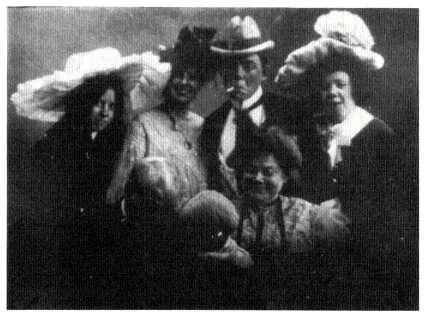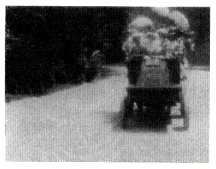The Edison Comedies
Although Porter took serious looks at American society, comedies were the mainstay of Edison production. Generally they worked within well-defined genres, like Poor Algy! and The Burglar's Slide for Life , or adapted narratives from fads and hit songs that had wide audience recognition. Many completely avoided any reference to societal concerns. Porter made one technical breakthrough that elevated several of his comedies from this period to the status of "novelties": it was a special form of object animation. As Porter applied the technique, a hodgepodge of letters moved against their black backgrounds until they formed the intertitles for the succeeding scene.[36] This was done for How Jones Lost His Roll (March 1905), The Whole Dam Family and the Dam Dog (May 1905), Coney Island at Night (June 1905), and Everybody Works but Father (November 1905).
When Edison's advertising manager, L. C. McChesney, sent out copy for How Jones Lost His Roll , he did not find it necessary to mention the film's narrative.

Postcard art was the source for The Whole Dam Family and the Dam Dog.
This film has already created a decided sensation in numerous Vaudeville Theatres, Moving Picture Entertainments, and among Exhibitors both in this country and abroad. There is not a dull or uninteresting moment throughout the entire picture while at several points the audience breaks into rounds of applause and laughter. From beginning to end the audience is kept in one continual state of expectancy. The illustrations which are reproduced from the film itself show "HOW JONES LOST HIS ROLL ," while the letters after much effort and manoeuvering disentangle themselves at intervals and tell the story in words. . . . Everyone wants to know how it is done.[37]
The story, about Jones who is systematically cheated of his money by a so-called friend, is told twice, in words and pictures, with the "jumble announcements" making the intertitles more important than the pictures they illuminate, inverting the normal relationship between image and title.
The humorous subversion of conventional narrative strategies was also an important aspect of The Whole Dam Family and the Dam Dog . Many films of this period (Biograph's The Firebug , Vitagraph's The Servant Girl Problem , and Edison's How a French Nobleman Got a Wife . . .) are introduced by a close-up of the main character(s) "so that his make-up, costume . . ., facial expression and bearing may be appreciated by the audience."[38] Sometimes, as with Biograph's The Widow and the Only Man , name cards at the bottom of the frame identify the individual. In The Whole Dam Family and the Dam Dog , each family member is introduced with a close-up and a name card—"Mr. I. B. Dam," "Miss U. B. Dam," and so on—at the bottom of the frame. These are followed by an abbreviated one-scene narrative as the Dam dog (Mannie) interrupts a family meal by pulling the tablecloth and all the dishes onto the floor. As Tom Gunning points out, the normal relationship between the introduction of characters and the development of narrative is reversed. Not only wordplay but playing with the audience's expectations of cinematic form contributed to the comedy's humor.
Edison advertising announced that The Whole Dam Family and the Dam Dog continued "a popular fad which has been widely advertised by lithographs and souvenir mailing cards and has recently been made the subject of a sketch in a New York Vaudeville Theatre."[39] Production records indicate that this film

The Whole Dam Family and the Dam Dog: a family portrait.
was shot in late May 1905, a month before the theatrical production had its debut at the Aerial Gardens in New York.[40] The Edison film was not indebted to the theatrical production for its conception; publicity merely referred to it as a general indication of the subject's timeliness and popularity. Rather it took the postcard caricatures and realized them in a series of facial expression "films." A group portrait follows, formally reprising the family panorama on the postcard. The dog's initial appearance in the final, narrative segment remains consistent with a left-to-right reading of the postcard as well as its place outside the enveloping dark background. If the subject was familiar, the company claimed to have used its "usual up-to-date methods" to illustrate "this popular subject in a most novel and original way." Narratization that gave new and special meaning to the designation of the family pet as "the Dam dog," the Edison dog itself, animated titles, and close-ups: all brought original elements to a popular fad, enabling Edison to sell 136 copies of the film during 1905-6. On the eve of the nickelodeon era, this combination of novelty and familiarity was the formula for commercial success.
Everybody Works but Father (November 1905) "opens with a laughable 'Jumble' Announcement—a new feature, exclusively Edison, mysterious and novel to a degree."[41] Its narrative was based on a song of the same title popularized by Lew Dockstader. Biograph had already made a similar film a month earlier, but without the animated intertitles. The Biograph film was advertised
as "a decided novelty for Illustrated Song Singers," and a surviving program urged the audience to join in the chorus, a strategy of exhibition not suggested in Edison promotional material.[42] Another Edison animated title from this period survives in the George Kleine Collection at the Library of Congress. This fragment reads "23 Skidoo," but has no accompanying picture. In any case, the Edison Company must have felt that the novelty of animated titles had been exhausted. Perhaps because Everybody Works but Father sold only forty-seven copies in the fifteen months after its release, the procedure was abandoned. J. Stuart Blackton, in contrast, soon applied the technique to new situations when he animated his sketches in Humorous Phases of Funny Faces (April 1906) and various stuffed animals in A Midwinter Night's Dream (December 1906). Porter was one of the first filmmakers to use animation techniques, but others were to see their broader possibilities.
Porter and his contemporaries frequently turned hit songs into comedies. In May 1905, a few months before making Everybody Works but Father , Porter photographed On a Good Old Five Cent Trolley Ride . This "burlesque on street car service"[43] was based on a song of the same title with the following chorus.
When speeding along on the trolley
I feel like a big millionaire.
A ride on the Trolley is jolly,
Whatever you give up is fare.
The Trolley's a hummer in summer
If you've got a girl at your side.
To tease in the breeze while you're stealing a squeeze,
On a good old five cent trolley ride.[44]
The Kinetograph Department suggested that "it greatly adds to the effectiveness of the picture if the music of the well-known popular song 'On a Good Old 5¢ Trolley Ride' is played while the picture is shown. The words and music of a portion of the chorus complete the picture."[45]
The Little Train Robbery (August 1905) was indebted to another well-known hit-this time in cinema. Porter burlesqued his own The Great Train Robbery by substituting children for adults and using a miniature railroad and playhouse as sets. The young robbers don't take money but candy and dolls. Their getaway replicates the escape in The Great Train Robbery , except that the delinquents are finally captured by full-grown policemen. The bandit queen who has organized the robbery, however, escapes. The film's stance was intended to be nostalgic. The Edison Company hoped that "while the young folks are enjoying themselves their elders can find equal enjoyment in recalling their own youthful days, when their highest ambition was to become a 'Jesse James,' or a 'Bandit Queen.' "[46] The film was nostalgic for another reason. Porter made the film at Olympia Park while visiting his hometown of Connellsville.[47] Released as the nickelodeon era was beginning, The Little Train Robbery must have

Boarding School Girls. The car wiggles down the road.
The scene suggested too much exuberance and was
removed.
disturbed literal-minded critics who saw storefront theaters as schools for crime. Such a film would have provided undesirable role models for the young. Even worse, it suggests that these children were modeling themselves on the bandits in a film "universally admitted to be the greatest production in MOTION PICTURES ." If the Kinetograph Department honestly expected the new film to "meet with the same unqualified approval and unprecedented success as The Great Train Robbery ,"[48] it was disappointed. The picture sold a meager thirty prints during 1905-6, when most of Porter's comedies sold two or three times that number.
Another Edison comedy, Boarding School Girls (July-August 1905), followed the students of Miss Knapp's Select School to Coney Island. As with Rube and Mandy at Coney Island (1903), the film enabled audiences to vicariously enjoy the famous resort through characters who were there on an outing. Although made only two years later, Boarding School Girls integrates narrative and spectacle, as well as performers and environment, in a much more seamless fashion. A remarkable traveling shot of the girls being driven to the amusement park, photographed from another moving vehicle, was removed after the first prints were made.[49] The scene can be found in the paper print version, but not in the otherwise complete negative at the Museum of Modern Art. Perhaps the playfulness appeared too dangerous (the car wiggles back and forth across the road) and bad for the school's image. Once the group arrives at the amusement park, "they take in everything in sight. Passing through Creation they capture the 'Miniature Railway' and 'shake' their governess who endeavors to overtake them. 'Shooting the Chutes,' 'Riding the Camels,' 'The Dew Drop,' 'Steeplechase' and 'Carousel' are all visited. A parade on the beach in bathing costumes is followed by a visit to the 'Flying Swings' and a dip in the surf. 'The Trolley,' 'Razzle Dazzle,' 'Moving Stairway,' 'The Twister' and 'Barrel of Love' are next visited in turn, until finally overtaken and captured by their governess they start for home."[50]
Another Porter comedy, produced in the fall or winter of 1905, was Minstrel Mishaps , which survives in the Kleine Collection at the Library of Congress. It was "conceived and produced by America's Only Minstrel Star, LEW
DOCKSTADER ,"[51] showing his "late arrival on the special, his dash to the theatre in the only cab in town, the great make-up scene, the minstrel band and the Biggest Knock-out Finish with Lew Dockstader himself in every scene." The film was toured as part of Dockstader's Minstrels in the spring of 1906 and "caused most laughter and applause."[52] By the end of 1907, Dockstader was selling the picture to film exchanges. A year later, the Edison Company bought the negative and sold the comedy as a regular release.